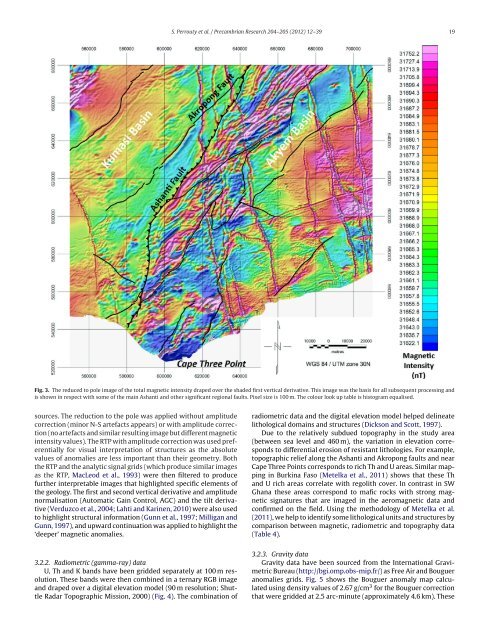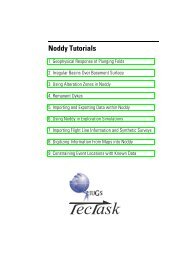Revised Eburnean geodynamic evolution of the ... - Tectonique.net
Revised Eburnean geodynamic evolution of the ... - Tectonique.net
Revised Eburnean geodynamic evolution of the ... - Tectonique.net
You also want an ePaper? Increase the reach of your titles
YUMPU automatically turns print PDFs into web optimized ePapers that Google loves.
S. Perrouty et al. / Precambrian Research 204– 205 (2012) 12– 39 19<br />
Fig. 3. The reduced to pole image <strong>of</strong> <strong>the</strong> total mag<strong>net</strong>ic intensity draped over <strong>the</strong> shaded first vertical derivative. This image was <strong>the</strong> basis for all subsequent processing and<br />
is shown in respect with some <strong>of</strong> <strong>the</strong> main Ashanti and o<strong>the</strong>r significant regional faults. Pixel size is 100 m. The colour look up table is histogram equalised.<br />
sources. The reduction to <strong>the</strong> pole was applied without amplitude<br />
correction (minor N-S artefacts appears) or with amplitude correction<br />
(no artefacts and similar resulting image but different mag<strong>net</strong>ic<br />
intensity values). The RTP with amplitude correction was used preferentially<br />
for visual interpretation <strong>of</strong> structures as <strong>the</strong> absolute<br />
values <strong>of</strong> anomalies are less important than <strong>the</strong>ir geometry. Both<br />
<strong>the</strong> RTP and <strong>the</strong> analytic signal grids (which produce similar images<br />
as <strong>the</strong> RTP, MacLeod et al., 1993) were <strong>the</strong>n filtered to produce<br />
fur<strong>the</strong>r interpretable images that highlighted specific elements <strong>of</strong><br />
<strong>the</strong> geology. The first and second vertical derivative and amplitude<br />
normalisation (Automatic Gain Control, AGC) and <strong>the</strong> tilt derivative<br />
(Verduzco et al., 2004; Lahti and Karinen, 2010) were also used<br />
to highlight structural information (Gunn et al., 1997; Milligan and<br />
Gunn, 1997), and upward continuation was applied to highlight <strong>the</strong><br />
‘deeper’ mag<strong>net</strong>ic anomalies.<br />
3.2.2. Radiometric (gamma-ray) data<br />
U, Th and K bands have been gridded separately at 100 m resolution.<br />
These bands were <strong>the</strong>n combined in a ternary RGB image<br />
and draped over a digital elevation model (90 m resolution; Shuttle<br />
Radar Topographic Mission, 2000) (Fig. 4). The combination <strong>of</strong><br />
radiometric data and <strong>the</strong> digital elevation model helped delineate<br />
lithological domains and structures (Dickson and Scott, 1997).<br />
Due to <strong>the</strong> relatively subdued topography in <strong>the</strong> study area<br />
(between sea level and 460 m), <strong>the</strong> variation in elevation corresponds<br />
to differential erosion <strong>of</strong> resistant lithologies. For example,<br />
topographic relief along <strong>the</strong> Ashanti and Akropong faults and near<br />
Cape Three Points corresponds to rich Th and U areas. Similar mapping<br />
in Burkina Faso (Metelka et al., 2011) shows that <strong>the</strong>se Th<br />
and U rich areas correlate with regolith cover. In contrast in SW<br />
Ghana <strong>the</strong>se areas correspond to mafic rocks with strong mag<strong>net</strong>ic<br />
signatures that are imaged in <strong>the</strong> aeromag<strong>net</strong>ic data and<br />
confirmed on <strong>the</strong> field. Using <strong>the</strong> methodology <strong>of</strong> Metelka et al.<br />
(2011), we help to identify some lithological units and structures by<br />
comparison between mag<strong>net</strong>ic, radiometric and topography data<br />
(Table 4).<br />
3.2.3. Gravity data<br />
Gravity data have been sourced from <strong>the</strong> International Gravimetric<br />
Bureau (http://bgi.omp.obs-mip.fr/) as Free Air and Bouguer<br />
anomalies grids. Fig. 5 shows <strong>the</strong> Bouguer anomaly map calculated<br />
using density values <strong>of</strong> 2.67 g/cm 3 for <strong>the</strong> Bouguer correction<br />
that were gridded at 2.5 arc-minute (approximately 4.6 km). These




